Hello and welcome back to Bake Experiments - where we play with flavours and techniques. With a bit of baking history & folklore thrown in too.
Thank you so much for being here. I hope you enjoy this post. And if you like what you read? Please do subscribe, share or like. Thank you.❤️
Last year in the UK, the Cheesecake was crowned our favourite tea time treat.
A survey showed its popularity had surpassed our beloved classics, like Victoria Sponge, Carrot Cake and Lemon Drizzle.
The survey was commissioned by UK retailer SPAR, as part of the Blooming Great Tea Party to raise money for end-of-life charity Marie Curie.
Ian Taylor, spokesman of the retailer, said: “With cheesecake coming out as the UK's top teatime treat, it's obvious that people are looking for bakes that give us flavours with inspiration from around the world.”
And the cheesecake is most certainly global. We are a world of cheesecake lovers, with variations across the globe.
A World of Cheesecake
I’m sure you have heard of the classic New York Cheesecake. Perhaps you have partaken in the craze for Burnt Basque? Or maybe you are a fan of the Japanese Cotton Cheesecake, an airy cross between New York cheesecake and chiffon cake.
How about Topfentorte - a light Austrian cheesecake made with Quark and often encased in fluffy sponge layers?
Or Smaland ostkaka - Sweden’s cheesecake, or curd cake, is so beloved, it has it’s own day on November 14th.
Other awesome sounding cheesecakes from around the globe include:
Sernik - a Polish variety, served as a Christmas treat.
Peynirli Kunefe - a Turkish cheesecake baked between two layers of fine pastry strands (or tel kadyif) and covered in a lemon syrup and pistachios.
Ube Cheesecake - an intensely purple cheesecake from the Philippines, with cream cheese mixed with mashed purple yams (ube halaya).
Vatrushka - a Russian sweetbread, a ring of dough filled with soft cheese.
What’s your favourite cheesecake? And what would you like to try on this list? I’d love to hear from you in comments.
Ricotta Cheesecake
My favourite cheesecake of the moment is a baked ricotta cheesecake. And today’s recipe was inspired by a starter I enjoyed in a chain Italian restaurant while on holiday.
The rest of the meal was… well, it was… ok. But this starter was sublime. A whipped feta and ricotta dip, smothered in orange blossom honey and served with rosemary crackers.
I knew even as I was eating it that I wanted to turn it into a baked cheesecake. And spent the rest of the holiday desperately thinking about cheesecake.
To the point that I ate a disappointingly cloying passion fruit cheesecake, just to try and quell the cravings.
It’s all about texture
Claggy, gritty cheesecakes are rubbish aren’t they? Unfortunately, I find them disappointingly common in UK restaurants. Perhaps because of the time and effort required to get it right.
What we are looking for is creamy, smooth, and light, with hints of citrus and saltiness to offset all that rich cheese.
The best way I have found to achieve this texture, is with a water bath. And to illustrate the power of the water bath - I have conducted a little experiment.
The Water Bath Experiment
First up, what do I mean by a water bath? Well, the base and sides of the cheesecake are wrapped tightly in foil, and placed in a roasting tray. Before boiling water is poured around the cheesecake to about halfway up the sides, making sure you don’t go above the foil.
The theory being that it will ensure a more even bake, and prevent the cheesecake from sinking or cracking.
As with all my experiments, I minimised my variables, following the same recipe to the letter. The only difference was that I placed one cheesecake in a water bath, and the other, I did not.
Results
The difference is remarkable. Not only did my ‘no water bath’ cheesecake sink in the middle as it was under baked, it also cracked at the edge - a sign of being over baked.
The water bath cheesecake was perfectly risen and baked all the way through, with no cracks.
What was perhaps most marked, was the difference in texture. Due to the water bath slowly and gently ‘poaching’ the cheesecake, and the extra humidity, the water bath cheesecake was gloriously smooth and melt in the mouth. We ate it so quickly, I’m impressed I got a photo at all.
The no water bath cheesecake on the other hand, was gritty and claggy. Despite having exactly the same flavour profile, it tasted… very off putting. We threw it away after one slice, which says it all really.
The recipe - Whipped Ricotta and Feta Cheesecake, with an Orange Blossom Honey, infused with Rosemary and Thyme Flowers
Level: Intermediate
Serves: 6-8 slices
Time: Approx. 1-2 hrs, and overnight chilling. If for a gathering, bake the day before.
Equipment needed: 1x 7in springform tin, large roasting tin for your water bath
Cheesecake base
100g digestive biscuits (or oat biscuits)
50g salted butter, melted
Cheesecake filling
250g ricotta cheese
75g feta cheese
93g caster sugar (golden, if you can get it)
1 tbsp cornflour
1 egg
1 tsp vanilla paste
1/2 tsp orange extract
The infused honey
2 generous tbsp orange blossom honey (if you can’t find orange blossom honey, either infuse the honey with some drops of extract, or a little orange zest)
2x small sprigs of rosemary
Small handful of thyme flowers
Method
First, infuse your honey glaze. Lightly chop your rosemary and some of your thyme flowers, toss in and mix with your honey (add your orange blossom extract or orange zest at this stage too, if using).
Leave some of your thyme flowers aside for decoration later.
Cover your honey and set aside.
To the cheesecake
Preheat your oven to 110°C Fan/130°C/230°F/Gas Mark 1/4
Butter and line your tin. I don’t mind my cheesecake edges looking a little rustic, so I have lined very simply. Just one sheet well pushed all the way round the tin will make the cheesecake easier to remove later.
Scrunch a piece of foil around the outside of the tin to cover the bottom and up the sides - this is to stop the water from your water bath seeping into your cheesecake.
Blitz up your biscuits in a food processor until they are fine, before pouring in your melted butter and mixing again.
Pour them into your prepared tin, and smooth them down into an even, well packed base.
Moving onto your filling. Place your feta and ricotta into a stand mixer, or use an electric whisk to whip up your cheese. Add the rest of your ingredients to bring them all together, until super smooth and very liquidy.
Tap the bowl to expel any air bubbles before pouring your filling on top of your base.
Set up your water bath. Boil your kettle and place your cheesecake into a large roasting tin.
Pour your boiled water all around the cheesecake and up to about halfway around the tin - but don’t let the water come higher than the foil.
Place in the oven and bake for around 30 minutes.
To ensure your cheesecake doesn’t crack, you need to let it cool slowly. Once baked, turn off your oven and leave it in there for at least ten minutes.
Then transfer, still in the water bath, to cool on a rack. It needs to entirely cool in the water bath before you dry it off, cover and place in the fridge to set.
After your cheesecake has been setting for around four hours, you can add your honey glaze. Pour it on top of the cheesecake and use a pastry brush to spread it to the edges. I keep the cheesecake in its case at this stage, to ensure the honey doesn’t run off the sides.
Cover and place the cheesecake back in the fridge overnight. Chilling it overnight and letting that syrup soak in a little will make it the creamiest, smoothest, most moreish cheesecake you have ever known. It’s worth the wait!
Keep covered in the fridge and let it sit out at room temperature for 20-30 minutes before serving.
When ready to serve, sprinkle on the last of the thyme flowers. You can add a little more rosemary too, if you like. I haven’t gone too overboard with decoration here. This cheesecake is all about the flavour and silky smooth texture.
This baby doesn’t last long though, a day or two at most. So, enjoy!
Until next time…

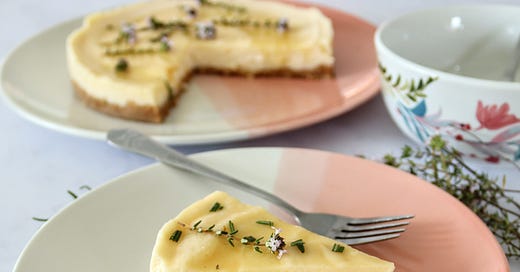


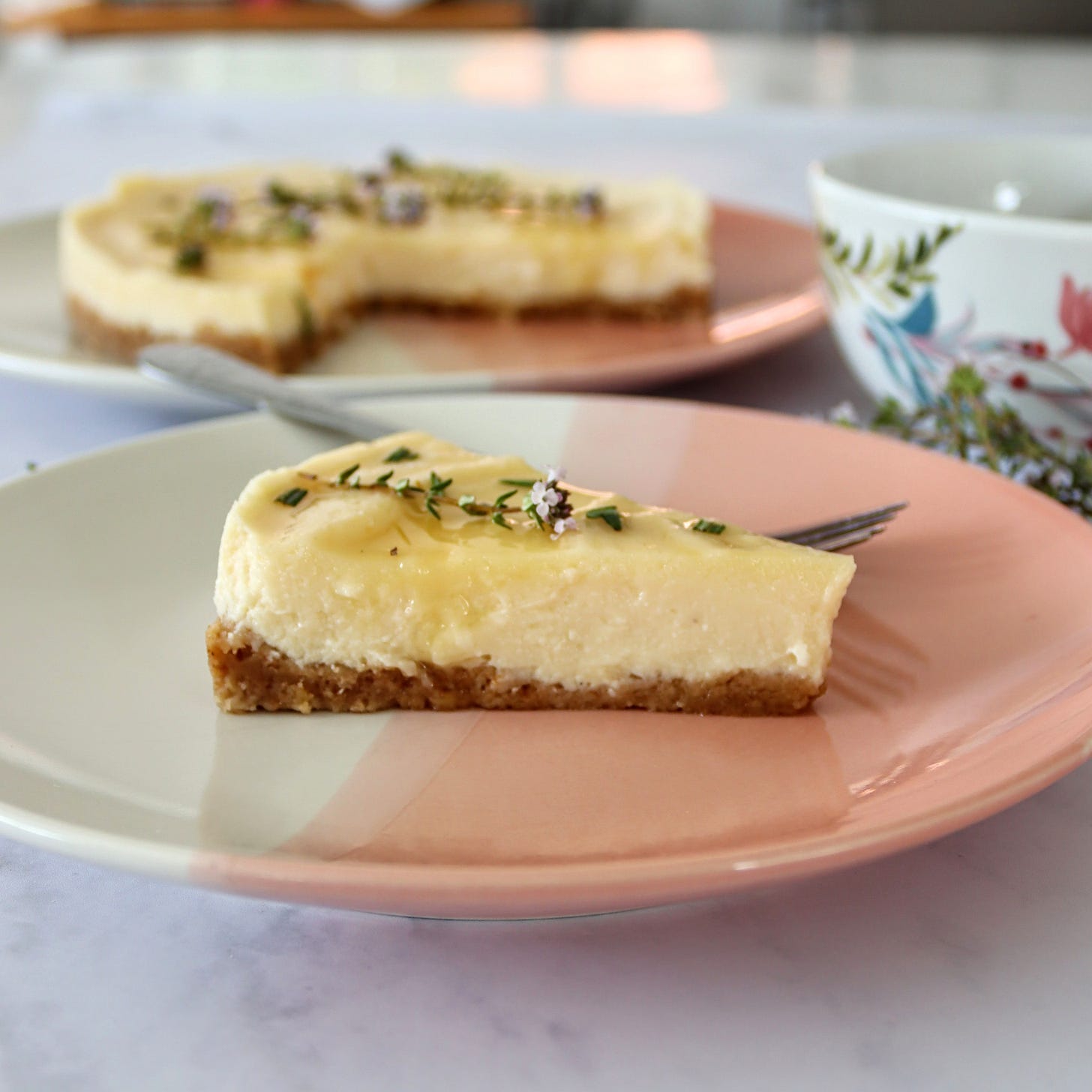
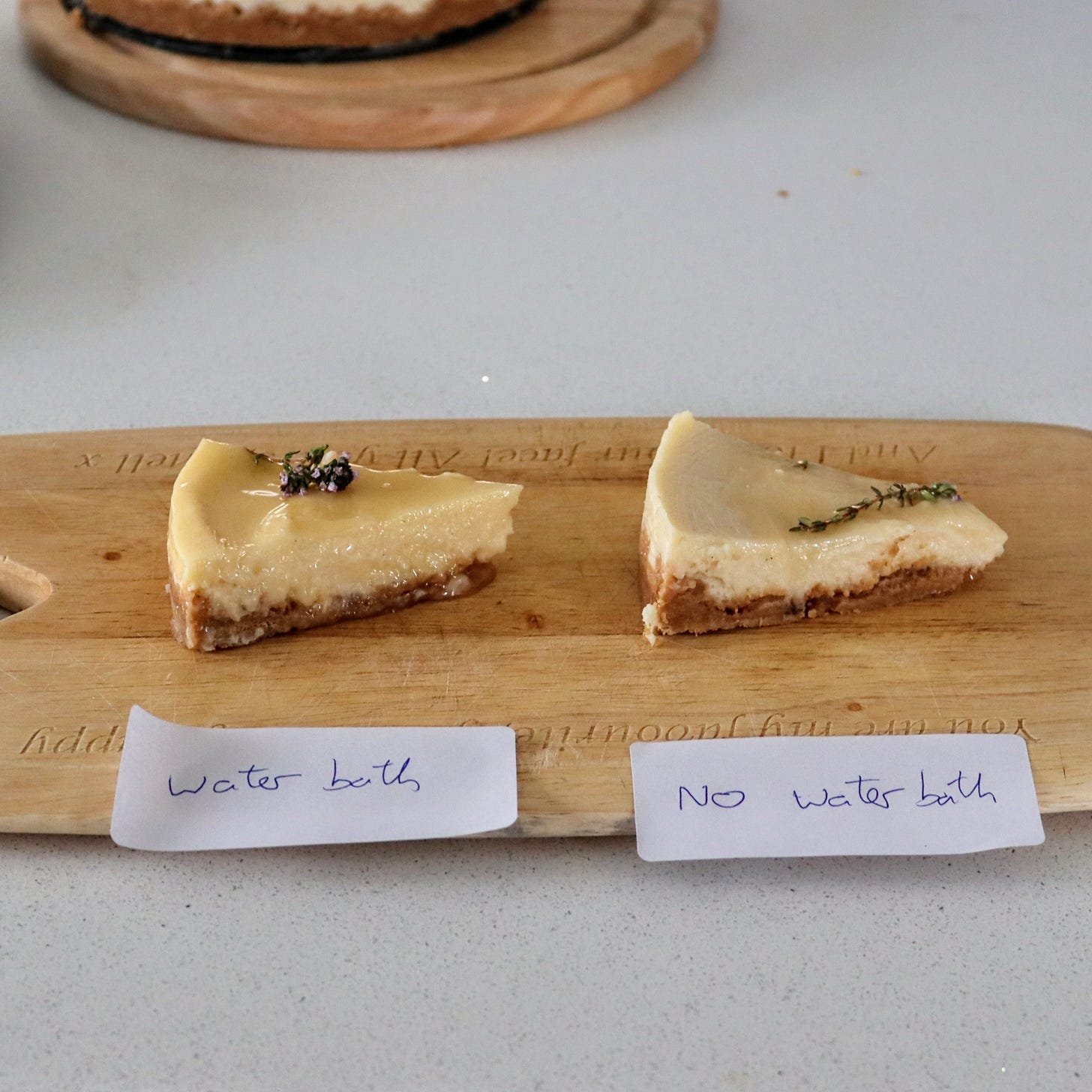
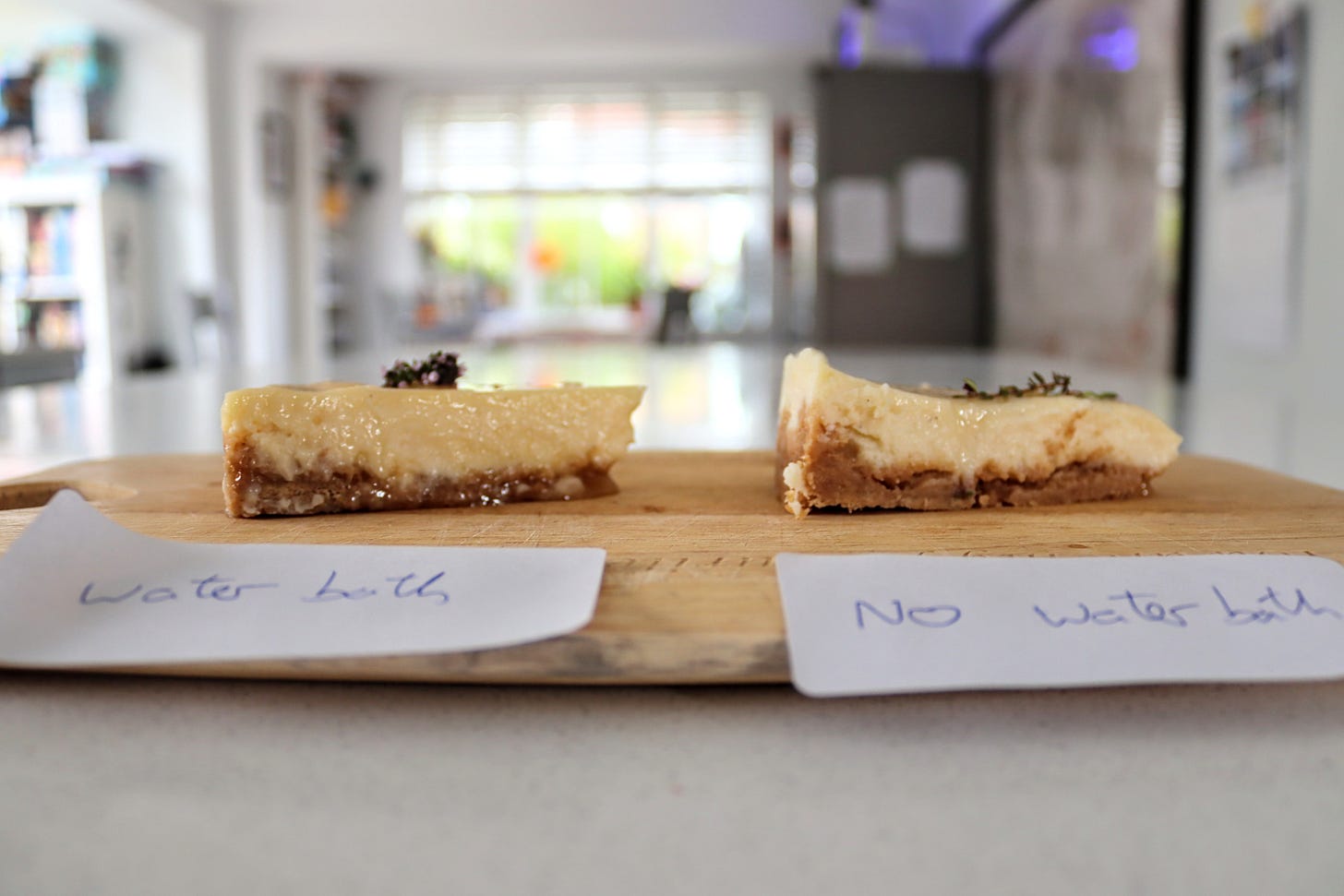
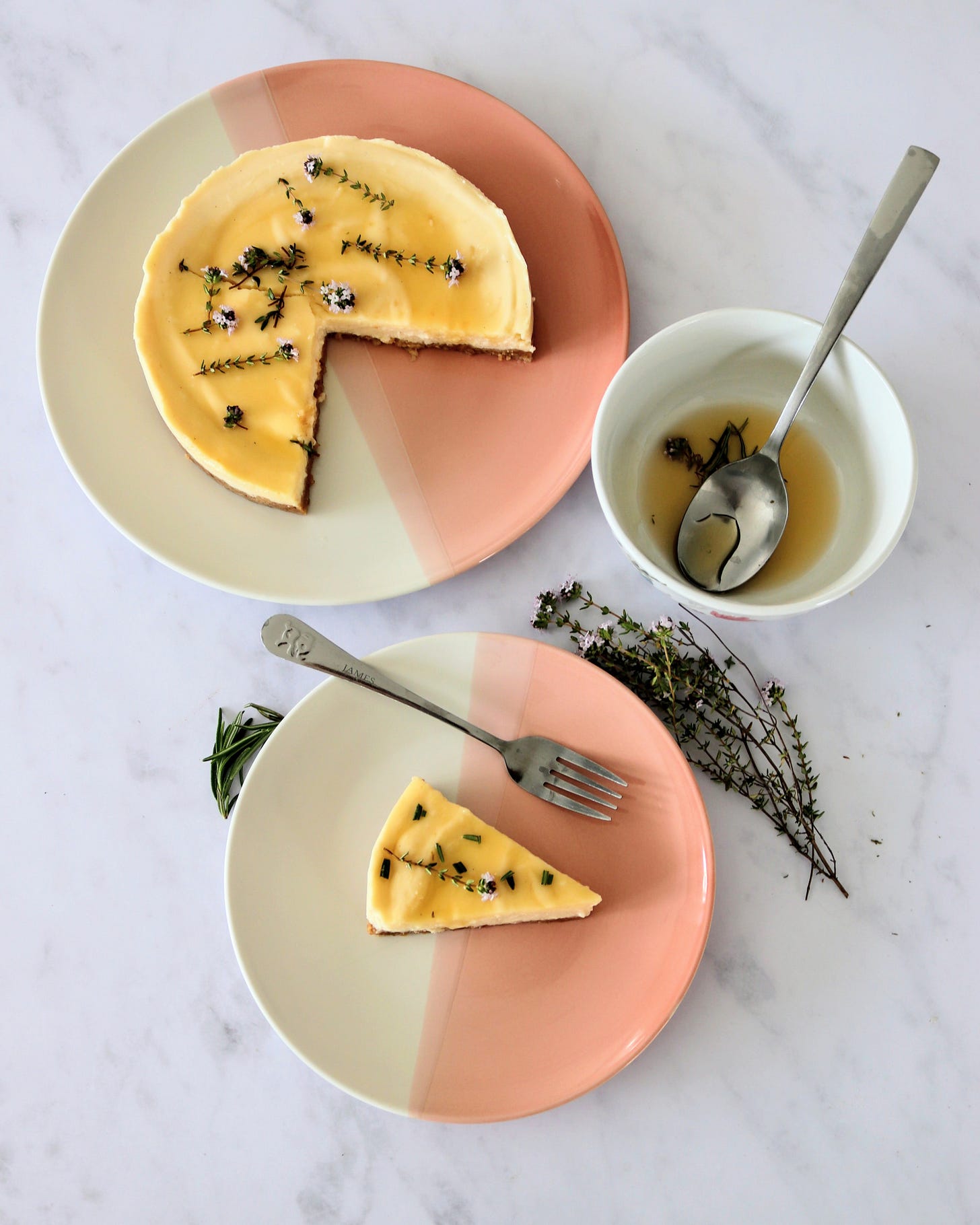

Great tip to chill overnight to let the syrup soak in. Looks like the ultimate in cheesecake sophistication!
This looks good Shell, I’m loving the herb glaze.